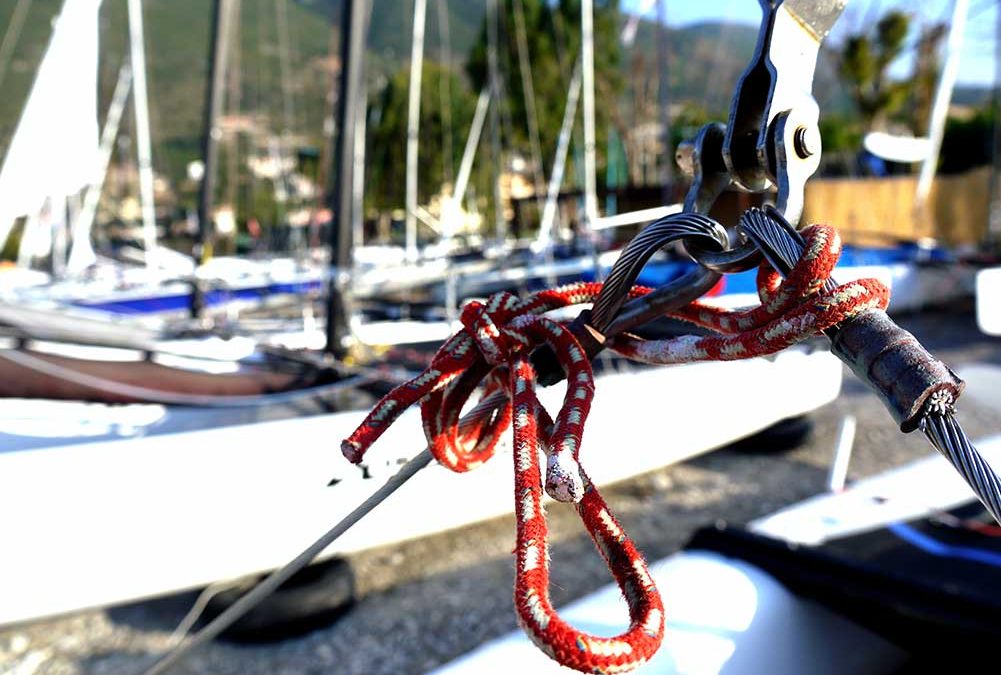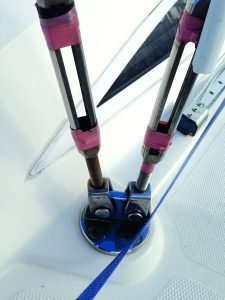The rig of a sailing boat is put under huge stresses and strains so it is important for inspections of a yacht’s spars and rigging to be carried out at regular intervals.
All the elements of a sailing rig – the mast, spreaders, boom, kicker, stays and the fittings that hold everything together – are subjected to considerable forces when at sea.
Less obvious perhaps is that the process of cyclic loading, the cause of metal fatigue, continues unabated even when a boat is rocking gently on a sheltered mooring. The rig components continue to push and pull against each other, day in and day out. Added to the all stresses and strains imposed on the rig components are their susceptibility to different kinds of corrosion, caused in the case of aluminium masts both by exposure to the marine environment on the one hand and also by galvanic corrosion. This occurs when stainless steel or bronze fittings are fitted to aluminium masts and not adequately insulated from each other, which causes the aluminium to corrode. While wooden masts do not suffer from galvanic corrosion, they are susceptible to rot and de-lamination.
Rig care
As with many other kinds of boat care, regular checks, preventative maintenance and the correct set up of mast and rigging are key to ensuring longevity and preventing failure. With sailing boat rigs in particular, the integrity of all their parts is vital. The mast and rigging is a lightweight structure designed to be rigid and strong, a bit like a house of cards – if one of the components fails then the whole house comes tumbling down. Even if one part becomes loose this can increase loads on other parts, causing them to fail.
While doing regular checks of your rig throughout the sailing season is good practice, so too is a more detailed inspection when the boat comes ashore and if needs be the mast can be taken down. Even if the rig remains unstepped ashore it still needs to be checked by a trained eye.
Understanding your rig
There are many kinds of mast and rig configurations for sailing boats and it is important for boat owners to fully understand the rig set up of their particular boat. This understanding will help them know what to look out for when doing their regular checks. Here are a few questions that owners should be able to answer:
Standing rigging
- What are the main causes of rig failure?
- When was the mast last unstepped? Once every two or three years is generally recommended.
- When was the standing rigging last inspected? Annual inspections are usually recommended.
- When was the standing rigging last replaced? Once every ten years or so is usually recommended for wire rigging and about fifteen years for rod rigging.
- Where are the main stress points on your rig?
- How do you check the rig alignment?
Running rigging
- When was the running rigging last inspected?
- When should it be replaced?
- What maintenance needs to be done?
Causes of rig failure
While many sailors live in fear of rogue waves and capsize, most dismastings happen either because of equipment failure or operator error. Leaving aside operator error, the main reasons include the failure of chainplates, spreaders, turnbuckles and tangs caused by either metal fatigue, corrosion or a combination of the two.
Chainplate failure is one of the most common causes of dismasting. Chainplates are not easy to inspect as they are hidden from view beneath the deck. Corrosion happens out of sight where the metal cannot be inspected without the plates first being removed.
Other causes are the failure of terminal fittings, clevis pins, cotter pins and all the parts that hold a rig together.
Surprisingly perhaps, the mast and stays are rarely the components that break first and cause a dismasting.
Stresses and loads
The components of a rig are designed to withstand certain stress levels and loads caused by a boat under sail in varying conditions. The correct adjustment of the rig is important to maintain the rig’s strength and longevity for a number of reasons – not just the boat’s performance and ability to point to windward. These include:
- If the rigging is slack problems can develop as it moves about, causing fatigue.
- Rig components can become weakened by vibrations caused for example as sails flog in strong winds, or by shock loading caused for example by accidental gybes.
- The misalignment of part of a rig can cause other parts to be overloaded resulting in metal fatigue and eventual failure.
- Stress coupled with corrosion will accelerate the potential for rig failure.
Crevice corrosion
Some surface rust on stainless steel rigging is normal and usually polishes off very easily. While stainless steel does not rust in the way that regular steel does, it does suffer from crevice corrosion.
Crevice corrosion occurs because the stainless steel has been deprived of oxygen. As a result its protective oxide film breaks down, allowing chlorides to infiltrate and corrode the metal. This happens around joints and under fastener heads and where pieces of metal are in close contact. Chainplates often suffer from this type of corrosion where they pass through the deck and sea water has saturated the deck core.
Crevice corrosion also takes place where cyclic loading has caused stainless steel to develop hairline cracks on the metal’s surface. Sea water then gets into the cracks and the corrosion slowly takes hold.
Galvanic corrosion
Aluminium masts with stainless steel fittings are at risk from galvanic corrosion. Galvanic corrosion is the transfer of electrons from one metal (the anode) to another (the cathode). In this case the anode is the aluminium and the cathode is the stainless steel. Positively charged electrons flow from the the anode to the negatively charged cathode. Galvanic corrosion also requires an electrolyte, a liquid that enables the electron flow to take place. In this case salt water is the electrolyte and a very efficient one.
Note: All stainless steel fittings should be insulated from aluminium masts by washers or sealant










